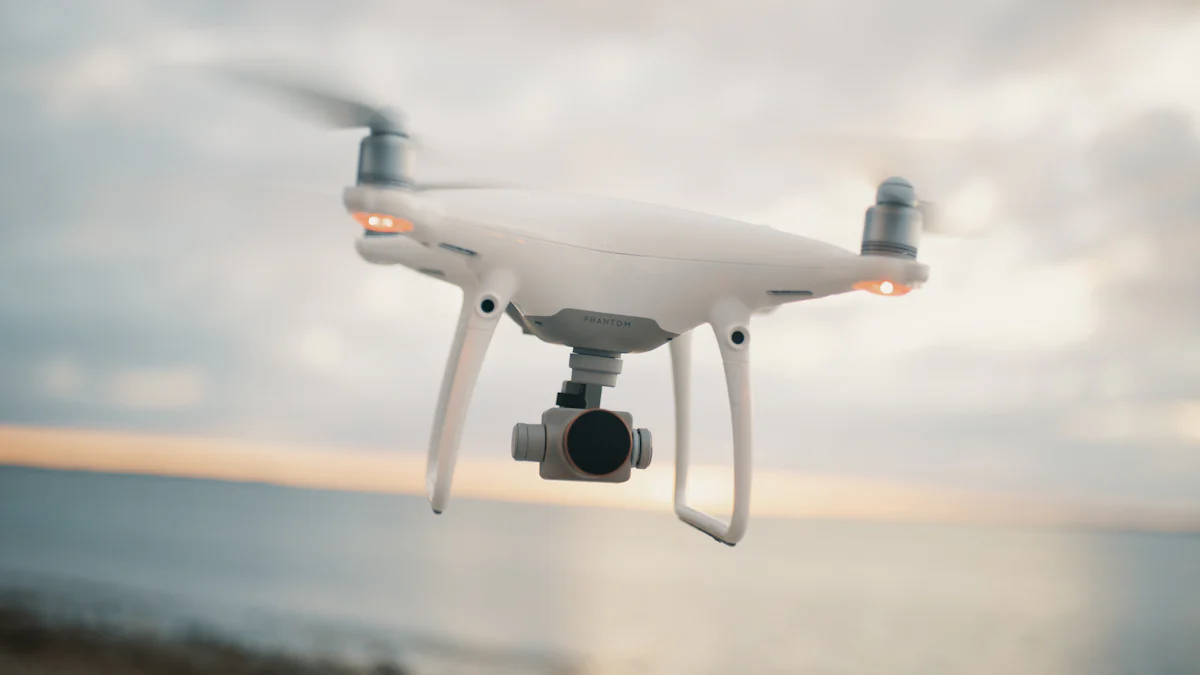How to Choose the Best DJI Drone with Thermal Camera for FPV and iSun Analog FPV Thermal Camera

Understanding Thermal Cameras in Drones
Thermal cameras have revolutionized the capabilities of drones, especially in applications such as search and rescue, surveillance, and infrastructure inspection. In this section, we will delve into the basics of thermal imaging and explore key features to consider when choosing a drone with a thermal camera.
The Basics of Thermal Imaging
How Thermal Cameras Work
Thermal cameras operate based on the detection of heat emitted by objects. Unlike traditional cameras that capture visible light, thermal cameras detect infrared radiation. This technology allows them to create images based on temperature differences, making it possible to visualize objects even in complete darkness or through obstacles such as smoke or fog.
Benefits of Thermal Imaging in Drones
The integration of thermal imaging in drones offers several advantages. It enables operators to identify heat signatures from a distance, making it invaluable for search and rescue missions where locating individuals in challenging environments is crucial. Additionally, thermal imaging aids in identifying anomalies in machinery and infrastructure by detecting variations in temperature that may indicate potential issues.
Key Features to Look for in a Drone Thermal Camera
When evaluating drone thermal cameras, certain features are essential to consider:
Resolution and Sensitivity
The resolution of a thermal camera determines the level of detail it can capture. Higher resolutions result in clearer images with more precise temperature variations. Sensitivity refers to the camera's ability to detect minimal temperature differences, which is vital for accurate thermal analysis.
Range and Field of View
The range specifies how far the thermal camera can detect heat signatures effectively. A longer range allows for broader coverage during aerial inspections or search operations. The field of view indicates the extent of the area captured by the camera, influencing the overall visibility and scope of thermal imaging.
Exploring DJI Drones with Thermal Cameras
As the demand for thermal imaging capabilities in drones continues to grow, DJI has introduced several models equipped with thermal cameras. Understanding the features and capabilities of these drones is essential for choosing the best option to suit specific operational requirements.
What DJI Drone Has Thermal Camera
DJI offers a range of drones with integrated thermal cameras, including the DJI Mavic 2 Enterprise Dual and the DJI Mavic 2 Enterprise Advanced. These drones are designed to provide high-quality thermal imaging for various professional applications, making them valuable tools for industries such as public safety, infrastructure inspection, and environmental monitoring.
Comparing Features and Capabilities
Thermal Imaging Quality
Both the DJI Mavic 2 Enterprise Dual and the DJI Mavic 2 Enterprise Advanced are equipped with high-performance thermal cameras that offer exceptional image quality. The thermal imaging sensors incorporated into these drones provide precise temperature measurements and detailed visual representations of heat signatures. This level of quality ensures reliable detection of anomalies and accurate assessment of thermal data during operations.
Drone Performance and Usability
In terms of overall performance and usability, there are distinct differences between the two models. The DJI Mavic 2 Enterprise Dual is known for its compact design and portability, making it ideal for rapid deployment in emergency situations. On the other hand, the DJI Mavic 2 Enterprise Advanced boasts advanced flight capabilities and enhanced endurance, allowing for extended flight missions and more comprehensive aerial coverage. Additionally, both models feature intuitive controls and user-friendly interfaces, ensuring ease of operation for pilots with varying levels of experience.
The Role of FPV in Thermal Imaging
First-person view (FPV) technology has significantly enhanced the capabilities of thermal imaging in drones, providing operators with real-time visual feedback and expanding the range of applications for thermal cameras.
Understanding FPV Thermal Camera Technology
How FPV Enhances Thermal Imaging
FPV technology enhances thermal imaging by enabling operators to have a live view of the thermal feed directly from the drone's perspective. This real-time feedback allows for immediate decision-making during missions, such as search and rescue operations or surveillance tasks. By integrating FPV with thermal cameras, operators can precisely navigate the drone to focus on specific heat signatures, ensuring efficient and accurate data collection.
Applications of FPV Thermal Cameras
The integration of FPV thermal cameras has broadened the scope of applications for thermal imaging in drones. In addition to traditional uses such as search and rescue and infrastructure inspection, FPV technology enables precise monitoring of wildlife habitats, identification of heat loss in buildings, and detection of hotspots in firefighting scenarios. The real-time visualization provided by FPV enhances situational awareness, making it an invaluable tool across various industries.
DJI Matrice 300 RTK and Zenmuse H20T
Features and Benefits
The DJI Matrice 300 RTK is compatible with the Zenmuse H20T, a versatile payload that includes an integrated FPV thermal camera. This combination offers advanced capabilities for aerial inspections and data collection. The Zenmuse H20T's FPV thermal camera provides high-resolution thermal imaging with exceptional clarity, allowing operators to identify temperature differentials accurately. Additionally, the Matrice 300 RTK's robust flight performance ensures stable and reliable operation even in challenging environmental conditions.
Practical Use Cases
The integration of the DJI Matrice 300 RTK with the Zenmuse H20T's FPV thermal camera opens up a wide range of practical use cases. From monitoring critical infrastructure for potential issues to conducting precision agriculture assessments, this combination delivers comprehensive aerial intelligence for various industries. Furthermore, in public safety applications such as firefighting or law enforcement operations, the real-time visual feedback from the FPV thermal camera enables swift decision-making and enhances operational efficiency.
Integrating the iSun Analog FPV Thermal Camera
In the realm of thermal imaging for drones, the iSun analog FPV thermal camera stands out as a versatile and reliable option for integrating thermal imaging capabilities into aerial operations. Understanding the key features and advantages of this camera, as well as its compatibility with various drones, is essential for harnessing its full potential.
Why Choose the iSun Analog FPV Thermal Camera
Key Features and Advantages
The iSun analog FPV thermal camera offers a range of advanced features that set it apart in the realm of thermal imaging technology. With its compact design and lightweight construction, this camera provides seamless integration onto a variety of drone platforms without compromising flight performance. Its high-resolution thermal imaging capabilities ensure precise temperature measurements and detailed visual representations, empowering operators to identify heat differentials with exceptional clarity. Furthermore, the real-time analog feed from the camera enhances situational awareness during missions, enabling swift decision-making and efficient data collection.
Compatibility with Drones
The iSun analog FPV thermal camera is designed to be compatible with a wide array of drones, making it a versatile solution for diverse operational needs. Whether integrated onto DJI platforms or other drone models, this camera seamlessly interfaces with existing systems to deliver reliable thermal imaging capabilities. Its plug-and-play functionality simplifies installation and setup, allowing operators to quickly deploy the camera for various applications such as infrastructure inspections, wildlife monitoring, and search and rescue missions.
Step-by-Step Guide to Integration
Equipment Needed
Compatible drone platform (e.g., DJI Mavic series or similar)
iSun analog FPV thermal camera
Mounting hardware or gimbal for secure attachment
Analog video transmitter/receiver system
Display monitor or goggles for real-time viewing
Installation Process
Begin by ensuring that the drone platform is powered off to prevent any accidental activation during installation.
Identify a suitable mounting location on the drone where the iSun analog FPV thermal camera can be securely attached without obstructing other components or affecting flight dynamics.
Carefully mount the camera using compatible hardware or a gimbal system to maintain stability during flight operations.
Connect the analog video transmitter/receiver system to facilitate real-time transmission of thermal imagery from the camera to a display monitor or goggles.
Power on the drone platform and verify that the iSun analog FPV thermal camera is functioning correctly by conducting a brief test flight in a controlled environment.
See Also
Selecting the Top Drone Thermal Imaging Camera for FPV: iSun Analog FPV Guide
Picking the Perfect Analog FPV Thermal Camera for Your DJI Drone
Selecting the Top FPV Thermal Camera for DJI Drones
Selecting the Perfect FPV Thermal Camera for Your Drone
Selecting the Top Analog FPV Thermal Camera for Drones with Thermal Tech
Contact Us: Ms. Coco Huang
E-mail: sales@iasun.cn
WhatsApp/Wechat: +86 13510421923

